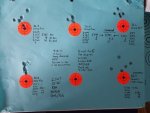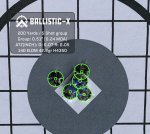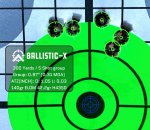I was wondering if anyone has tried the 6.5 guys 10 shot ladder test and if it worked for them.
Identifying a consistent and accurate load for your precision rifle while improving the overall efficiency of the load development process is a laudable goal. The 6.5 Guys met with Scott Satterlee to discuss and explore a technique he calls the “10 Round Load Development Ladder Test”. This is a load development approach he has refined to quickly identify accuracy nodes with only 10 rounds. Additional cartridges are then loaded to test and confirm these accuracy nodes. Scott’s approach really interested us as load development has traditionally been a time intensive and laborious process.
A lot of folks ask us if Scott’s methods are a replacement for OCW. When asked that question, Scott responds that his method uses a chronograph to get to the same answer as OCW. Prior to the availability of the extremely portable and accurate Magnetospeed, shooting groups as prescribed by the OCW method was the most practical way to arrive at an optimal load. Long story short, if you want to use the OCW method as promulgated by Dan Newberry there is absolutely nothing wrong with it. However, Scott believes his method is more efficient and arrives at the correct answer faster.
The following quote from Scott summarizes a key observation with load development, “Im not sure it is optimal charge weight at all but optimal velocity for the bullet weight that determines barrel harmonics. The reason I say this is because I can get the exact same great results in a velocity node using seven different powders. As long as I keep the bullet going the same velocity from powder to powder I get the same result. Powder charge may be slightly different but as long as I’m in the velocity happy place for that bullet and my cartridge, powder is secondary.”
Scott’s method is predicated on the shooter having their reloading techniques dialed in. After the release of the video, we had a number of viewers ask us what Scott does to perfect his reloading technique. We can tell you from personal experience that we have adopted many of Scott’s techniques and they work:
“I start 1.5 grains below my max load and load 10 shells ascending by .2 gr. So for the Swedemoor, 50.0, .2, .4, .6, .8, 51.0, .2, .4, .6, .8, 52.0
Then I will shoot these over the chronograph and look for the nodes. A node will be a velocity flat spot where .4-.8 gr of powder doesn’t move the speedometer much. This example with Reloader 26 in my 6.5 Addiction with 140 RDFs, the flat spot is between 51.2 and 51.8 grains -velocity went from 3025-3033 fps. So, .8 grains of powder added a total of 8 fps. Therefore, the middle of my node is 51.5 grains.
Next I then load up 5 of the 51.5 grain load and shoot them over the chronograph and the extreme spread was 5 FPS. I have repeated this with H100V, H4350, 4831, 1000, Retumbo, RE 17,19, 22, 23, 26, wiN 760, 780, VV 160, 170, 560, 570 IMR 4451, 4955, 7828 and 7977. With all of these powders, 3020-3035 fps was an accuracy node without regard to the powder type.
Once I find the velocity node I load in the middle of it then fiddle with COAL until it shoots tiny groups with low low extreme spreads. You can have an accurate load at 100 yards that will not shoot past 600 yards because you have a high extreme spread. For me any extreme spread that is over 25 FPS is unacceptable no matter how small the group is at 100 yards. Even if I had a load that shot .1 moa at 100 yard yet had an ES of 30, I wouldn’t use that load for a match. I would take a .3 moa load that had a sub 10 fps extreme spread any day of the week because the load will not start to spread vertically past 600.”
Identifying a consistent and accurate load for your precision rifle while improving the overall efficiency of the load development process is a laudable goal. The 6.5 Guys met with Scott Satterlee to discuss and explore a technique he calls the “10 Round Load Development Ladder Test”. This is a load development approach he has refined to quickly identify accuracy nodes with only 10 rounds. Additional cartridges are then loaded to test and confirm these accuracy nodes. Scott’s approach really interested us as load development has traditionally been a time intensive and laborious process.
A lot of folks ask us if Scott’s methods are a replacement for OCW. When asked that question, Scott responds that his method uses a chronograph to get to the same answer as OCW. Prior to the availability of the extremely portable and accurate Magnetospeed, shooting groups as prescribed by the OCW method was the most practical way to arrive at an optimal load. Long story short, if you want to use the OCW method as promulgated by Dan Newberry there is absolutely nothing wrong with it. However, Scott believes his method is more efficient and arrives at the correct answer faster.
The following quote from Scott summarizes a key observation with load development, “Im not sure it is optimal charge weight at all but optimal velocity for the bullet weight that determines barrel harmonics. The reason I say this is because I can get the exact same great results in a velocity node using seven different powders. As long as I keep the bullet going the same velocity from powder to powder I get the same result. Powder charge may be slightly different but as long as I’m in the velocity happy place for that bullet and my cartridge, powder is secondary.”
Scott’s method is predicated on the shooter having their reloading techniques dialed in. After the release of the video, we had a number of viewers ask us what Scott does to perfect his reloading technique. We can tell you from personal experience that we have adopted many of Scott’s techniques and they work:
- Brass makes a big difference. Buy good brass and be done with it.
- Get a good chronograph. From a convenience and accuracy standpoint, theMagnetospeed is hard to beat.
- Sort your brass by lot and the number of times they have been fired. We can’t tell you how many inquiries we get from folks who purchase mixed lots of brass at the local outdoor store and wonder why they can’t find a good load.
- Annealing works. There was an experiment done by a reputable company and super smart guys, but the experiment was too limited to replicate high volume shooters. Take a look at our article on the AMP annealer where we discuss this.
- Powder weight is pretty important. Measure every single charge unless you are reloading in volume for a gas gun or pistol. A lot of folks use the RCBS Chargemaster and certain modifications can be made to really dial them in. This will be the subject of a future article.
- Find a load length that gets your bullets off the lands. A load that is jammed into the lands will not have durability and you will have to readjust them frequently. VLD bullets can be jump tolerant and extremely accurate well off the lands. The followingarticle from Berger Bullets confirms this.
- Remove primers as a separate step using a dedicated die such as the Lee Universal Decapper. We’ve conducted experiments where using the sizing die to decap increases runout.
- Use a mandrel instead of an expander ball. We’ve noticed less runout and lower SDs by doing this. Get a carbide mandrel so you can remove any burrs or imperfections after you remove the sizing lube from the brass. A mandrel also helps in conditioning the necks on virgin brass and avoids the need to full length size virgin brass.
- Pay attention to primer seating. Seat the primer until the anvil touches the bottom of the primer pocket and go ever so slightly further (.001″) to pre-stress the priming compound. This requires a refined sense of feel that can take some time to develop. We’ve encountered shooters with dud rounds who claim “I’ve got some bad primers.” Almost without exception, they are not seating their primers deep enough.
- If running a compressed load, settle your powder. Check out our article on bullet seating.
“I start 1.5 grains below my max load and load 10 shells ascending by .2 gr. So for the Swedemoor, 50.0, .2, .4, .6, .8, 51.0, .2, .4, .6, .8, 52.0
Then I will shoot these over the chronograph and look for the nodes. A node will be a velocity flat spot where .4-.8 gr of powder doesn’t move the speedometer much. This example with Reloader 26 in my 6.5 Addiction with 140 RDFs, the flat spot is between 51.2 and 51.8 grains -velocity went from 3025-3033 fps. So, .8 grains of powder added a total of 8 fps. Therefore, the middle of my node is 51.5 grains.
Next I then load up 5 of the 51.5 grain load and shoot them over the chronograph and the extreme spread was 5 FPS. I have repeated this with H100V, H4350, 4831, 1000, Retumbo, RE 17,19, 22, 23, 26, wiN 760, 780, VV 160, 170, 560, 570 IMR 4451, 4955, 7828 and 7977. With all of these powders, 3020-3035 fps was an accuracy node without regard to the powder type.
Once I find the velocity node I load in the middle of it then fiddle with COAL until it shoots tiny groups with low low extreme spreads. You can have an accurate load at 100 yards that will not shoot past 600 yards because you have a high extreme spread. For me any extreme spread that is over 25 FPS is unacceptable no matter how small the group is at 100 yards. Even if I had a load that shot .1 moa at 100 yard yet had an ES of 30, I wouldn’t use that load for a match. I would take a .3 moa load that had a sub 10 fps extreme spread any day of the week because the load will not start to spread vertically past 600.”






